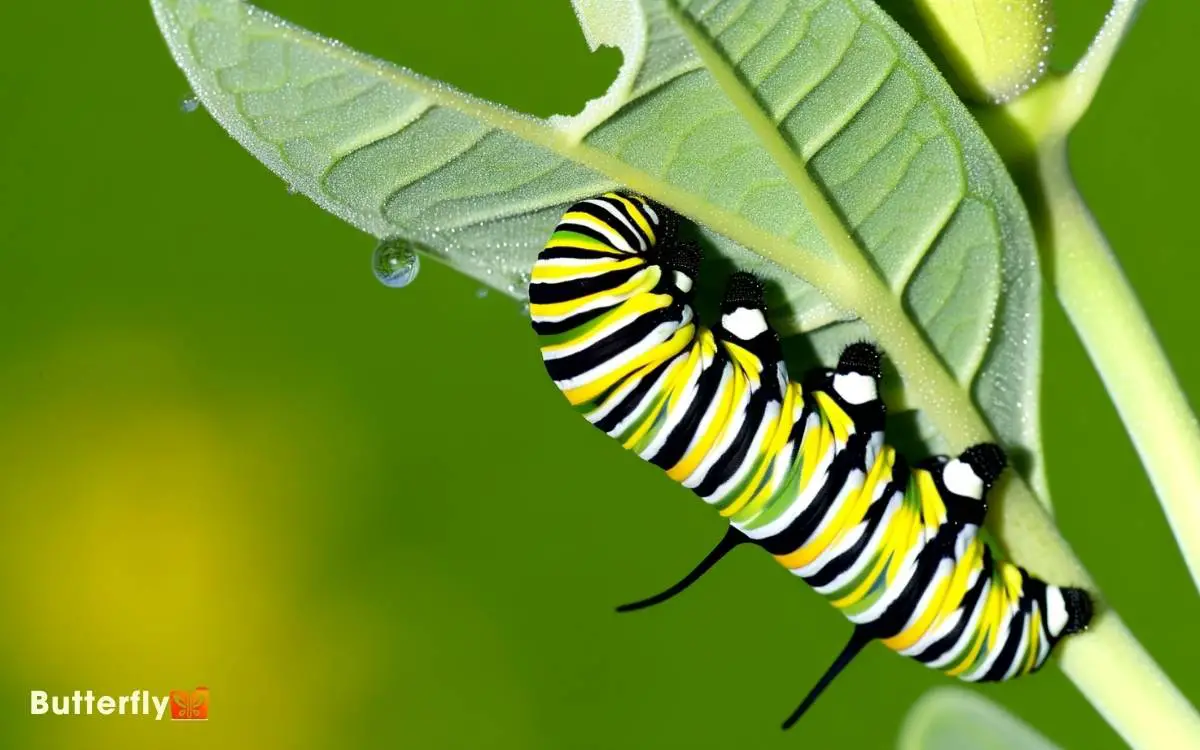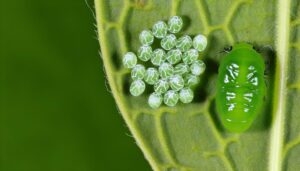Image of Monarch Butterfly Caterpillar: Find Out Here!
You’re looking at a Monarch butterfly caterpillar, evident by its vivid aposematic coloration of black, white, and yellow bands. Its cylindrical, segmented body sports fine setae and short, black sensory filaments on the head capsule.
This caterpillar uses specialized enzymes in its mandibles to consume milkweed leaves, which provide essential nutrients and chemical defenses.
It undergoes five larval stages, marked by molting and growth, found primarily in meadows and grasslands from Canada to Central America.
Habitat conservation and proper photography techniques can capture its intricate details, offering an intriguing glimpse into its lifecycle and ecological role.

Key Takeaways
Visual Characteristics
The Monarch butterfly caterpillar is easily identified by its striking bands of black, white, and yellow that run longitudinally along its body. These bands serve as aposematic coloration, warning potential predators of its toxicity.
You’ll notice the caterpillar’s body is cylindrical, segmented, and covered in fine setae, or tiny hairs. It has three pairs of true legs located near its head and five pairs of prolegs along its abdomen, providing stability and grip on foliage.
The caterpillar’s head capsule features a pair of short, black filaments and another pair on its posterior end, which may help in sensory perception.
By closely examining these visual characteristics, you can distinguish the Monarch caterpillar from other similar species in its habitat.
Feeding Habits
You’ll observe that monarch butterfly caterpillars exhibit a strong preference for milkweed plants, which are essential for their survival.
These caterpillars actively consume milkweed leaves, utilizing specialized enzymes to break down the plant’s toxic compounds.
This feeding behavior not only provides vital nutrients but also confers chemical defenses against predators.
Milkweed Plant Preference
Although monarch butterfly caterpillars exhibit strong feeding preferences, they primarily consume milkweed plants due to the presence of cardenolides, which provide both nourishment and a chemical defense against predators.
You’ll find that these caterpillars are highly selective within the Asclepias genus, displaying a distinct predilection for specific milkweed species. This preference is driven by the cardenolide concentration, which varies among species.
For instance, they often favor Asclepias curassavica (tropical milkweed) for its ideal balance of nutrients and toxins.
Observations reveal that caterpillars meticulously chew leaves, avoiding older, tough foliage. This selective feeding behavior ensures they ingest maximum cardenolides, enhancing their survival rates against predation.
Consequently, understanding these preferences is essential for conservation efforts and habitat restoration projects.
Nutrient Absorption Process
Ingesting milkweed leaves, monarch butterfly caterpillars utilize specialized mandibles to efficiently break down plant tissue, initiating the nutrient absorption process.
You’ll notice that their robust mandibles are adept at tearing through tough leaf fibers, facilitating the intake of essential nutrients.
As the caterpillar ingests the plant material, digestive enzymes in its gut further decompose the cellulose, starches, and proteins.
The midgut, lined with microvilli, plays an essential role by maximizing nutrient absorption. Here, key compounds such as amino acids, glucose, and fatty acids are absorbed into the caterpillar’s bloodstream.
These nutrients fuel growth and development, enabling the caterpillar to progress through its larval stages. Understanding this process highlights the importance of milkweed in the monarch’s life cycle.
Growth Stages
Monarch butterfly caterpillars undergo a series of five distinct growth stages, known as instars, each marked by specific morphological changes and increased size.
You’ll notice that during each instar, the caterpillar molts, shedding its exoskeleton to allow for further growth.
First instar caterpillars are tiny, measuring about 2-6 mm. By the fifth instar, they can reach lengths of up to 45 mm.
Each molt reveals more pronounced stripes and larger tentacle-like appendages. The caterpillar’s mandibles also grow stronger, enabling it to consume more milkweed leaves efficiently.
Observing these stages reveals the intricate process of larval development, characterized by significant physiological adaptations, preparing the caterpillar for the pupal stage and eventually emerging as an adult monarch butterfly.
Habitat and Range
You’ll find monarch butterfly caterpillars primarily in regions where milkweed plants thrive, as these are their primary food source.
Their geographic distribution spans from southern Canada through the United States to Central America.
Seasonal migration patterns are essential; monarch populations migrate to specific overwintering sites in Mexico and California, optimizing survival rates during colder months.
Preferred Natural Environments
The monarch butterfly caterpillar primarily thrives in habitats rich in milkweed plants, which serve as their exclusive food source and breeding ground.
You’ll find them in meadows, grasslands, and along roadsides where milkweed is abundant. Their larval stage depends entirely on milkweed leaves, containing cardenolides that offer chemical defense against predators.
You’ll notice that these caterpillars prefer areas with ample sunlight, essential for the growth of milkweed. Additionally, regions with low pesticide use are vital, as chemicals can devastate both milkweed and caterpillar populations.
Look for caterpillars on the underside of milkweed leaves, where they feed and hide from potential threats.
Understanding these habitat preferences helps in conserving and fostering environments conducive to monarch butterfly caterpillar development.
Geographic Distribution Patterns
In North America, monarch butterfly caterpillars are mainly found from southern Canada through the United States and into Central Mexico, following the distribution of milkweed plants.
You’ll notice that these plants are essential because they provide the primary food source for the caterpillars. Monarchs prefer open fields, meadows, and roadsides where milkweed thrives.
Observations show that caterpillars’ habitat range is closely tied to the availability of these plants. Factors such as climate, soil type, and land use influence milkweed growth, thereby affecting caterpillar distribution.
Urbanization and agricultural practices can fragment or reduce their habitat. Understanding these geographic distribution patterns helps in conservation efforts aimed at preserving milkweed populations and, consequently, the monarch caterpillar habitats.
Seasonal Migration Routes
Understanding monarch butterfly caterpillars’ geographic distribution sets the stage for examining their remarkable seasonal migration routes, which span thousands of miles across North America. These routes are critical for survival and involve complex, multi-generational journeys.
Key observations include:
- Spring Migration: Monarchs move from Mexico to the southern U.S., laying eggs on milkweed plants.
- Summer Breeding: Successive generations spread northward to Canada, expanding the population.
- Fall Migration: Adult monarchs travel back to Mexico, covering up to 3,000 miles.
- Overwintering: Monarchs cluster in Mexican oyamel fir forests, entering a state of diapause.
These migration patterns are influenced by environmental cues such as temperature and daylight. Understanding these routes enhances your appreciation of the monarch’s incredible endurance and navigation capabilities.
Role in Ecosystem
Acting as both herbivores and prey, monarch butterfly caterpillars play a crucial role in maintaining the ecological balance within their habitats.
You’ll observe that as herbivores, they consume milkweed plants, which contain toxic compounds called cardenolides. This not only helps control milkweed populations but also renders the caterpillars toxic to many predators.
However, they’re still preyed upon by specialized predators like certain birds and insects that have developed immunity to these toxins.
Their role extends beyond simple predation; they’re key in nutrient cycling. When caterpillars and their predators die, their decomposition returns essential nutrients to the soil, fostering plant growth.
Photography Tips
Capturing the intricate details of monarch butterfly caterpillars requires a macro lens to highlight their vibrant colors and unique patterns. You’ll need to take into account several technical aspects to achieve the best results.
- Lighting: Use natural light to avoid harsh shadows and preserve the true colors of the caterpillar.
- Aperture: Set a narrow aperture (high f-stop) to guarantee a deep depth of field, capturing all parts of the caterpillar in sharp focus.
- Stability: Employ a tripod to eliminate camera shake and maintain precise focus on the caterpillar’s textures.
- Timing: Photograph during early morning or late afternoon when caterpillars are more active and the light is softer.
These tips will help you achieve scientifically accurate and visually stunning images of monarch butterfly caterpillars.
Conservation Efforts
Efforts to conserve monarch butterfly caterpillars hinge on restoring their natural habitats and mitigating threats from pesticides and climate change.
You’ll find that planting native milkweed is essential, as it serves as both food and breeding ground. Avoid using neonicotinoid pesticides, which are highly toxic to monarchs at larval and adult stages.
Climate change exacerbates habitat loss by altering the availability of milkweed and nectar sources.
Engage in citizen science projects to monitor caterpillar populations and migration patterns. Participate in habitat restoration by creating monarch waystations with milkweed and nectar plants.
Supporting agricultural practices that reduce pesticide usage can also make a significant impact. Your actions directly contribute to the survival and resilience of these iconic caterpillars.
Interesting Facts
Beyond conservation efforts, monarch butterfly caterpillars exhibit fascinating biological adaptations, such as their ability to sequester toxins from milkweed to deter predators.
You’ll find these caterpillars possess remarkable traits that are essential for their survival:
- Aposematic Coloration: Their bright yellow, black, and white stripes serve as a warning sign to potential predators of their toxicity.
- Osmeterium: When threatened, caterpillars can evert this gland, releasing foul-smelling chemicals.
- Instars: They undergo five distinct growth stages, or instars, each marked by molting.
- Rapid Growth: They can increase their mass nearly 2,700 times from hatching until pupation.
Understanding these adaptations provides insight into their evolutionary success and helps in their conservation.
Conclusion
In observing the monarch butterfly caterpillar, you’ve discovered its striking visual characteristics, understood its feeding habits, and traced its growth stages.
You’ve learned about its habitat and range, its essential role in the ecosystem, and picked up some photography tips.
Conservation efforts are essential to its survival, and you now know some fascinating facts. By appreciating these details, you’ll not only contribute to its preservation but also deepen your connection to the natural world.






